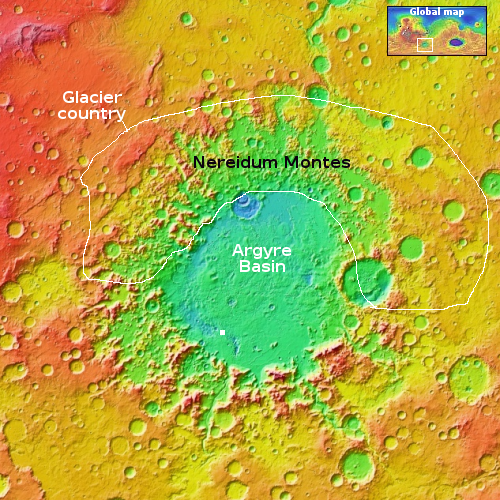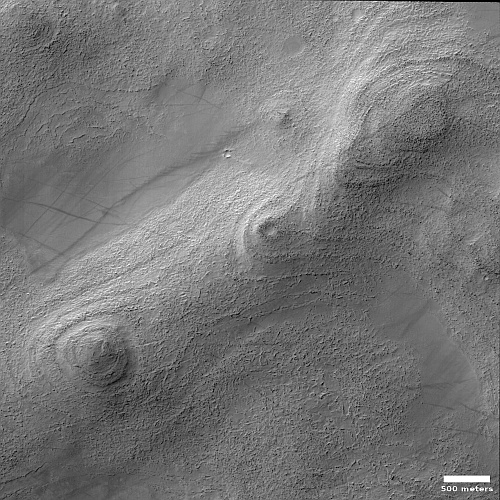Soft Martian buttes
Cool image time! The picture to the right, rotated, cropped, reduced, and sharpened to post here, was taken on January 1, 2023 by the high resolution camera on Mars Reconnaissance Orbiter to fill a gap in its shooting schedule so that the scientists could maintain the camera at its proper temperature.
In other words, the picture was not taken as part of any particular research project. Its target was in a sense chosen almost at random, though the science team always tries to find something of interest in such situations. In this case I think they succeeded, as these soft terraced buttes illustrate well the alien nature of Mars. The ground is barren, with absolutely no evidence of any life, and it appears that the buttes have been softened and eroded by eons of wind action. You can see evidence of this by the handful of dust devil tracks that cross the buttes.
There is more.

The white dot in the southwest quadrant of Argyre Basin marks the location. Argyre Basin, though not as deep or as large as Hellas Basin to the east, is still the second largest such basin on Mars, about 1,100 miles in diameter with its lowest elevation 17,000 feet below the surrounding southern cratered highlands. Like Hellas, it is thought to be the remains of major impact.
Based on another image within Argyre, it appears that wind and dust devils are common factors for shaping the surface in this basin. It also appears from a different image that soft terraced buttes within Argyre are also not uncommon.
At 54 degrees south latitude there is also another factor that probably influences the look of these buttes. At this latitude orbital images have shown much evidence of near surface ice. I would not be surprised therefore if water ice impregnates this ground, which in turn helps contribute to the buttes’ soft and stippled appearance.
Other factors however could explain this. If you look at the full image a crater just to the south of these buttes appears as soft, with its interior appearing entirely filled with what looks like a pond of dust (though this could also be a glacier that has experienced little erosion or sublimation). If dust however it suggests that there is a lot of dust and sand here, softening the view.
On Christmas Eve 1968 three Americans became the first humans to visit another world. What they did to celebrate was unexpected and profound, and will be remembered throughout all human history. Genesis: the Story of Apollo 8, Robert Zimmerman's classic history of humanity's first journey to another world, tells that story, and it is now available as both an ebook and an audiobook, both with a foreword by Valerie Anders and a new introduction by Robert Zimmerman.
The print edition can be purchased at Amazon or from any other book seller. If you want an autographed copy the price is $60 for the hardback and $45 for the paperback, plus $8 shipping for each. Go here for purchasing details. The ebook is available everywhere for $5.99 (before discount) at amazon, or direct from my ebook publisher, ebookit. If you buy it from ebookit you don't support the big tech companies and the author gets a bigger cut much sooner.
The audiobook is also available at all these vendors, and is also free with a 30-day trial membership to Audible.
"Not simply about one mission, [Genesis] is also the history of America's quest for the moon... Zimmerman has done a masterful job of tying disparate events together into a solid account of one of America's greatest human triumphs."--San Antonio Express-News
Cool image time! The picture to the right, rotated, cropped, reduced, and sharpened to post here, was taken on January 1, 2023 by the high resolution camera on Mars Reconnaissance Orbiter to fill a gap in its shooting schedule so that the scientists could maintain the camera at its proper temperature.
In other words, the picture was not taken as part of any particular research project. Its target was in a sense chosen almost at random, though the science team always tries to find something of interest in such situations. In this case I think they succeeded, as these soft terraced buttes illustrate well the alien nature of Mars. The ground is barren, with absolutely no evidence of any life, and it appears that the buttes have been softened and eroded by eons of wind action. You can see evidence of this by the handful of dust devil tracks that cross the buttes.
There is more.

The white dot in the southwest quadrant of Argyre Basin marks the location. Argyre Basin, though not as deep or as large as Hellas Basin to the east, is still the second largest such basin on Mars, about 1,100 miles in diameter with its lowest elevation 17,000 feet below the surrounding southern cratered highlands. Like Hellas, it is thought to be the remains of major impact.
Based on another image within Argyre, it appears that wind and dust devils are common factors for shaping the surface in this basin. It also appears from a different image that soft terraced buttes within Argyre are also not uncommon.
At 54 degrees south latitude there is also another factor that probably influences the look of these buttes. At this latitude orbital images have shown much evidence of near surface ice. I would not be surprised therefore if water ice impregnates this ground, which in turn helps contribute to the buttes’ soft and stippled appearance.
Other factors however could explain this. If you look at the full image a crater just to the south of these buttes appears as soft, with its interior appearing entirely filled with what looks like a pond of dust (though this could also be a glacier that has experienced little erosion or sublimation). If dust however it suggests that there is a lot of dust and sand here, softening the view.
On Christmas Eve 1968 three Americans became the first humans to visit another world. What they did to celebrate was unexpected and profound, and will be remembered throughout all human history. Genesis: the Story of Apollo 8, Robert Zimmerman's classic history of humanity's first journey to another world, tells that story, and it is now available as both an ebook and an audiobook, both with a foreword by Valerie Anders and a new introduction by Robert Zimmerman.
The print edition can be purchased at Amazon or from any other book seller. If you want an autographed copy the price is $60 for the hardback and $45 for the paperback, plus $8 shipping for each. Go here for purchasing details. The ebook is available everywhere for $5.99 (before discount) at amazon, or direct from my ebook publisher, ebookit. If you buy it from ebookit you don't support the big tech companies and the author gets a bigger cut much sooner.
The audiobook is also available at all these vendors, and is also free with a 30-day trial membership to Audible.
"Not simply about one mission, [Genesis] is also the history of America's quest for the moon... Zimmerman has done a masterful job of tying disparate events together into a solid account of one of America's greatest human triumphs."--San Antonio Express-News


